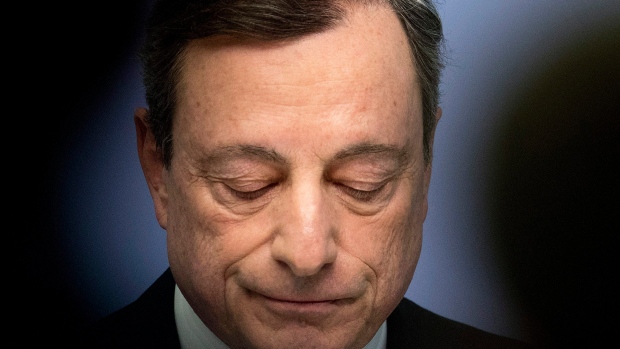Oct 24, 2019
'Whatever it takes': Key moments from Draghi's tenure at ECB
The Associated Press

FRANKFURT -- Here's a look at key moments and decisions from Mario Draghi's eight years at the head of the European Central Bank, the monetary authority for the 19 European Union countries that use the euro as their currency.
Nov. 1, 2011: Draghi takes over as European Central Bank president from Jean-Claude Trichet.
Nov. 3, Dec. 8, 2011: The bank's governing council cuts benchmark rates by 0.25% at each of Draghi's first two meetings amid a eurozone debt crisis.
Feb. 21, 2012: Eurozone governments approve a second, 130 billion-euro ($174 billion at the time) bailout for Greece.
July 26, 2012: Draghi tells a conference in London: "Within our mandate, the ECB is ready to do whatever it takes to preserve the euro. And believe me, it will be enough."
Sept. 6, 2012: Draghi follows up by promising unlimited purchases of eurozone government bonds if countries face excessive borrowing costs. Market borrowing costs fall, taking pressure off Italy and other governments. The backstop calms markets and never needs to be used.
June 5, 2014: ECB cuts the rate on overnight deposits from banks to below zero for the first time ever, to minus 0.1%.
Aug. 22, 2014: During a speech in Jackson Hole, Wyoming, Draghi signals ECB could start to pump newly printed money into the economy through a bond-buying program.
March 9, 2015: The ECB starts purchasing bonds.
March 10, 2016: The ECB cuts its main rates to new record lows - the deposit rate to minus 0.4%, and the lending rate to banks to zero.
Dec. 31, 2018: The bank ends its bond-buying stimulus program after 2.6 trillion euros ($2.6 trillion) in purchases.
Sept. 12, 2019: Citing risks from trade disputes and low inflation, ECB board reverses course, deciding to re-start the bond purchases at a rate of 20 billion euros per month, indefinitely, from
Nov.1: It cuts the deposit rate cut to minus 0.5%.
Oct. 31, 2019: Draghi completes his term, to be succeeded by former International Monetary Fund head Christine Lagarde.

